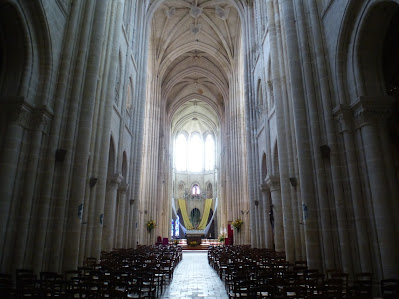We moved on, back inland, to Beauvais, a small city some 50 miles miles north of Paris. Historically it was the the home of the Jacquerie, the
peasants' revolt, and was also a great textile and tapestry center—the
National Museum of Tapestry is here. But the main reason for
visiting Beauvais nowadays is its great
uncompleted Cathedral
of St. Pierre.
In the mid 13th century, the
town fathers, lords, and clergy of Beauvais decided to build a
cathedral higher than all the others going up all over France
and Europe. No one would question the religious bent of
this decision. Nearer to thee, etc. Theology of height and light.
Etc. But cathedrals in this age were also major economic undertakings, enthusiastically supported by royalty, nobility,
merchants, guilds, the people...and the Church's introduction of
indulgences (direct payment
for salvation). The Chambre de Commerce, had it been around, would
have heartily approved. Destination tourism. Pilgrims. Civic pride.
Sign of divine favor. Etc. So St. Pierre's in Beauvais went up, and
up, and up. Its crossing, is indeed the highest of them all.
And then things
came tumbling down, down, down. The envelope—architectural,
ecclesiastical, economic—had been pushed too far. The choir was
completed by 1263, but in 1272 its vault, 157 ft., collapsed.
Construction after the Hundred Years' War saw the building of the
transepts and the great crossing, 11m higher than anything else
known. But then it collapsed in 1573. The church remains uncompleted. There is no nave nor
west entrance. The building one sees today is essentially the choir and
transepts. But, for its great height, it is no less impressive as a
statement of Medieval aspiration.
 |
| Entrance, the south transept portal; really high up there... |
 |
View from the southeast; some work going on, yes; but note those huge, high
flying buttresses |
 |
| Inside, here is what you came for: the highest apse of this age |
 |
| Choir floor to ceiling |
 |
But there's a price: those are flying buttresses; all those others
we have talked about have one foot still on the ground... |
 |
| And some of the piers are being buttressed too |
 |
Thus; you mean those 3x8s are going to hold up all those thousands of tons of stone
blocks so high up in the air? OK, it's been standing there for 800 years; but we didn't
tarry taking extra pix |
 |
A bit of the elevation in the choir; note the glazed triforia,
each half bay with 4 lancets and 2 major oculi; and then
the hugely high clerestory windows and rose/oculi above
them |
 |
And here's all the elevation my camera could capture; huge
aisles, and within them more windows, blind triforia; all the
dimensions are enormous |
 |
There is some little glass; on the left, the ever popular
Tree of Jesse |
 |
| An Annunciation |
 |
| But it's the great height, and ambition, that impresses |
 |
The little tan caboose on the left is the nave of the Carolingian cathedral; all the
nave St. Pierre's will have; but it gives some sense of how far things had come in
a few hundred years |
















.jpg)





































